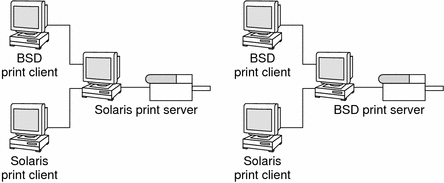You must decide which systems will have local printers physically attached to them. You must also decide which will systems use printers on other systems. A system that has a local printer attached to it and makes the printer available to other systems on the network is called a print server. A system that sends its print requests to a print server is called a print client.
The LP print service software provides printing services in the Solaris Operating System. Besides physically connecting a printer to a system, you must define the printer server characteristics to the LP print service. Once you have print servers set up, you can set up other systems as print clients.
Print servers and print clients can run different versions of the Solaris release and different versions of the UNIX operating system. Print clients running the Solaris 9 release and compatible versions can print to print servers that are running an lpd-based print service, such as the SunOS 4.1, BSD UNIX, and Linux releases. In addition, print clients running an lpd-based print service can print to print servers running the Solaris 9 release and compatible versions.
The following figure shows a print configuration on a network with systems running the Solaris release and an lpd-based print service. For details on how Solaris printing works in heterogeneous environments, see How Remote Printing Works.
